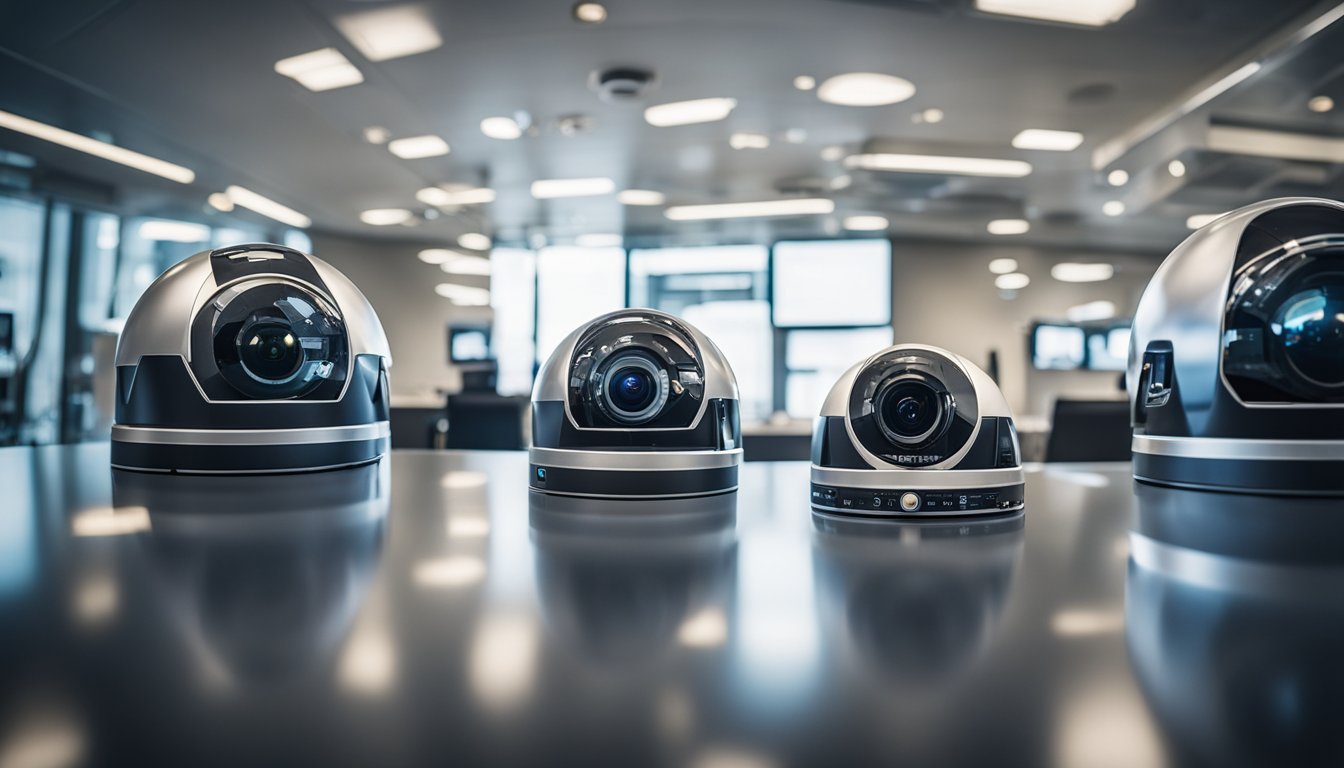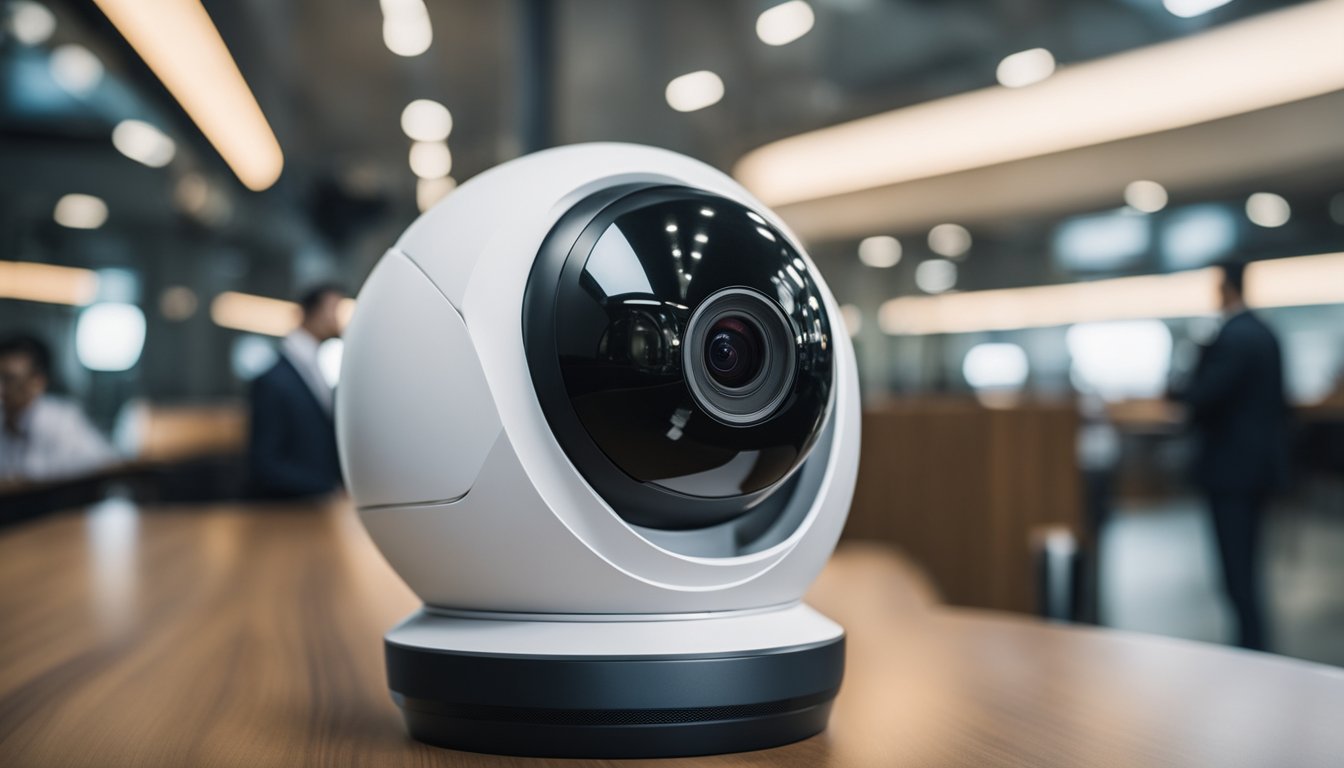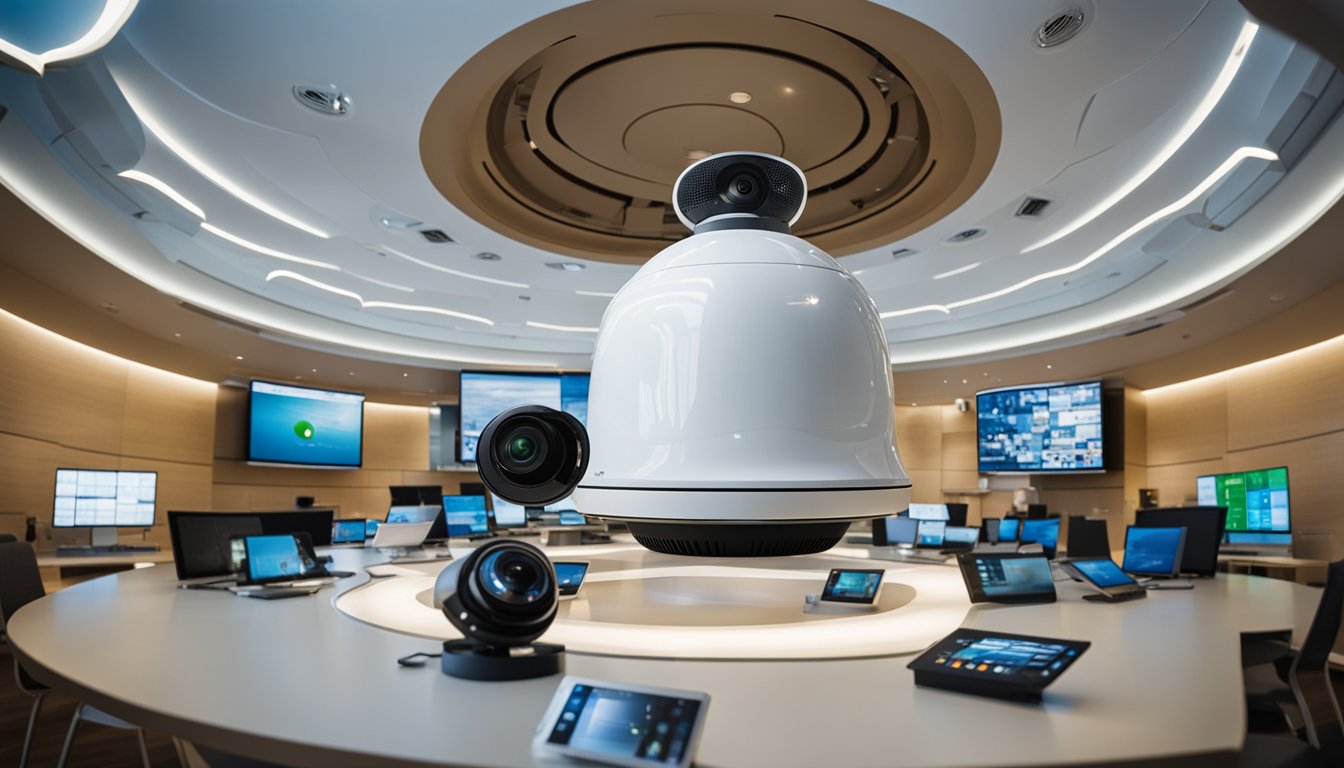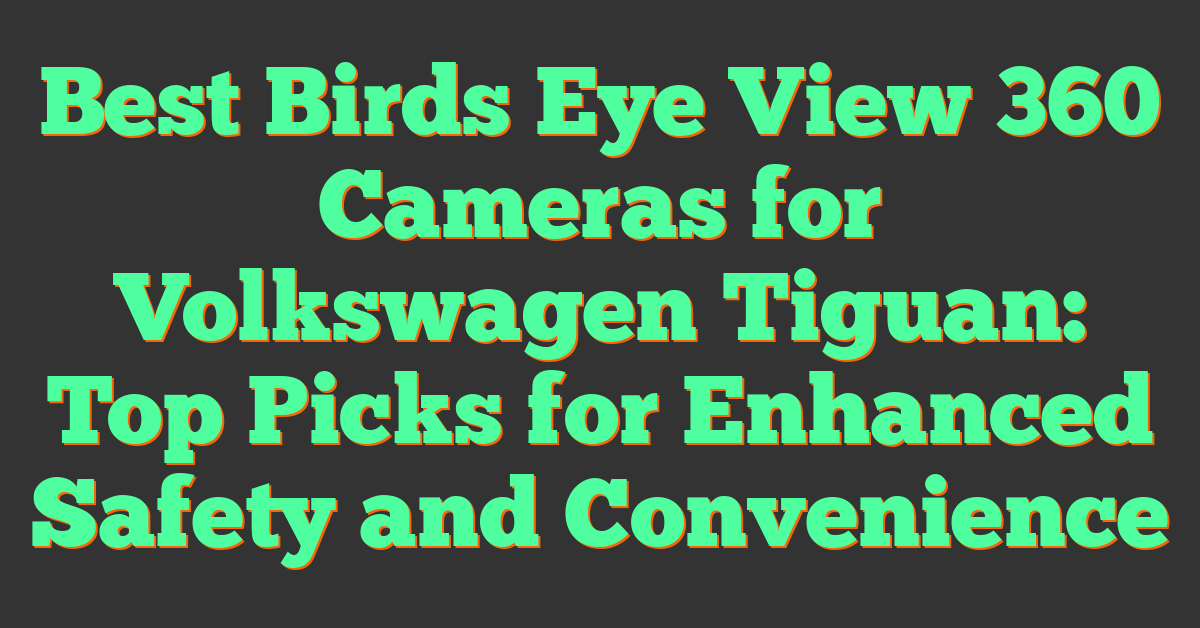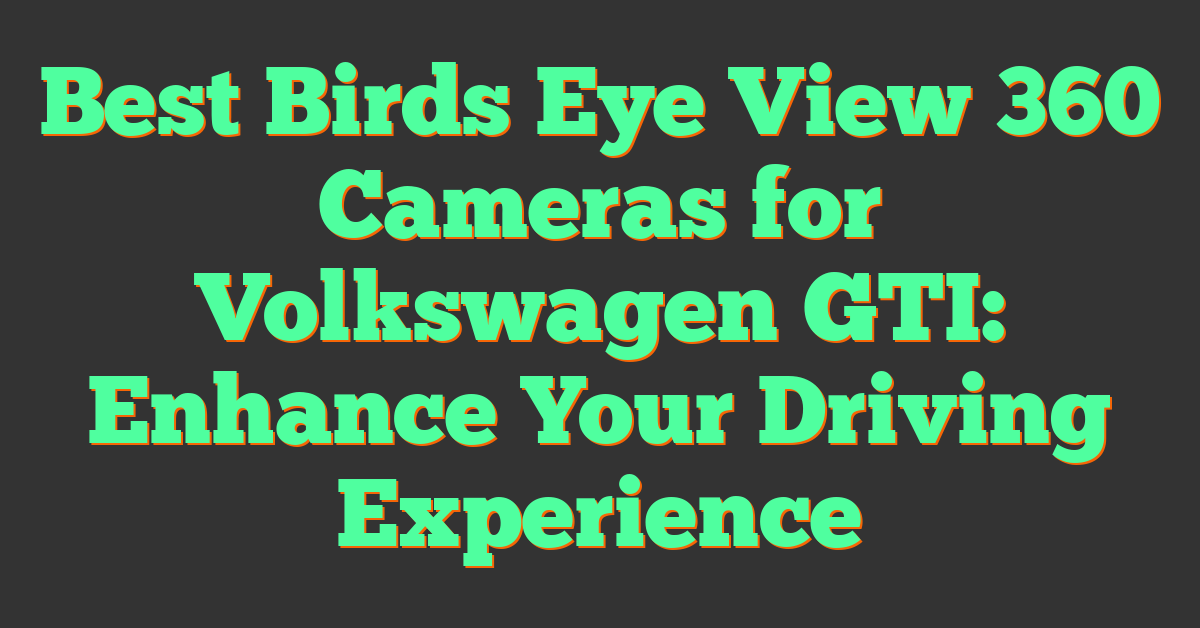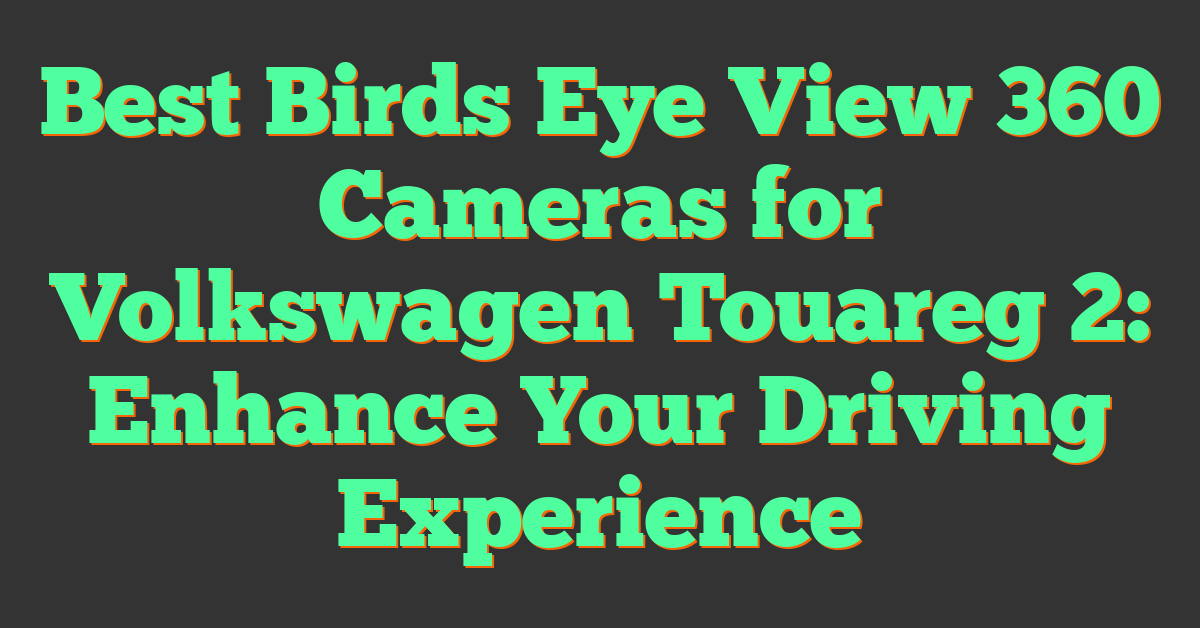Dome cameras are a popular choice for surveillance due to their discreet and unobtrusive design. These cameras are often used in indoor settings, such as retail stores, offices, and homes, to monitor activity and ensure security. One common misconception is whether dome cameras provide 360-degree coverage, and it’s important to clarify this aspect to understand their capabilities fully.
While dome cameras offer a wide viewing angle, not all models provide 360-degree coverage. The field of view typically ranges between 60 and 120 degrees, allowing them to capture images and videos from multiple directions. It’s essential to consider this factor when selecting a dome camera for your specific surveillance needs, as the coverage area varies based on the individual camera model and its intended application.
Key Takeaways
- Dome cameras do not always provide 360-degree coverage.
- The field of view for dome cameras typically ranges between 60 and 120 degrees.
- Consider the specific coverage area when choosing a dome camera for your surveillance needs.
Understanding Dome Cameras
https://www.youtube.com/watch?v=ZRAuVkgadqI&embed=true
Dome Camera Basics
Dome cameras are a type of security camera that is enclosed in a dome-shaped housing. They are commonly used for surveillance in various settings such as homes, businesses, and public places. The dome housing serves a dual purpose: it protects the camera from vandalism and also makes it difficult for people to see where the camera is pointing.
Dome cameras offer a wide viewing angle, making them ideal for capturing images and videos from multiple directions. They are also available in different sizes and styles, including indoor and outdoor models. Dome cameras can be mounted on walls or ceilings, and some models even come with pan-tilt-zoom (PTZ) capabilities, allowing you to remotely control the camera’s movement.
Types of Dome Cameras
There are several types of dome cameras available, each with its own set of features and benefits. Here are some of the most common types:
-
Fixed Dome Cameras: These cameras have a fixed lens and are designed to be discreet. They are ideal for indoor use and can be mounted on walls or ceilings. Fixed dome cameras are available in different resolutions, ranging from standard definition to high definition.
-
Vandal-Proof Dome Cameras: These cameras are designed to withstand vandalism and tampering. They are made with durable materials and come with features such as impact-resistant housing and tamper detection. Vandal-proof dome cameras are ideal for outdoor use in public places.
-
Infrared Dome Cameras: These cameras are equipped with infrared LEDs that allow them to capture images and videos in low-light conditions. They are ideal for use in areas with poor lighting, such as parking lots and alleys.
-
PTZ Dome Cameras: These cameras come with pan-tilt-zoom capabilities, allowing you to remotely control the camera’s movement. They are ideal for monitoring large areas and can be used both indoors and outdoors.
Overall, dome cameras are a popular choice for security and surveillance due to their versatility and wide range of features. Whether you need a discreet indoor camera or a vandal-proof outdoor camera, there is a dome camera that will meet your needs.
Design and Aesthetics
When it comes to security cameras, the design and aesthetics of the camera play a significant role in how well it blends into its surroundings. Dome cameras are known for their discreet design, which makes them a popular choice for both residential and commercial settings. The dome-shaped casing of the camera helps to conceal the direction in which the camera is pointing, making it difficult for intruders to tell which way the camera is facing.
Discreet Design
Dome cameras are designed to be discreet and blend in with their surroundings. They are typically installed on ceilings or walls, and their dome-shaped casing makes them difficult to spot. This discreet design makes them an ideal choice for businesses and homeowners who want to monitor their property without drawing attention to the fact that they have security cameras installed.
Vandal-Proof Features
Dome cameras are also known for their vandal-proof features. The dome-shaped casing of the camera is made from tough, durable materials that can withstand attempts to damage or destroy the camera. This makes them an ideal choice for outdoor settings, where they may be exposed to harsh weather conditions or attempts at vandalism.
« Does Taigun Have 360 Camera? Find Out Now!
Best 360 Camera for Matterport: Top Picks for Immersive Virtual Tours »
In conclusion, dome cameras are an excellent choice for those who want a discreet and durable security camera solution. Their design and aesthetics make them an ideal choice for both residential and commercial settings, and their vandal-proof features ensure that they can withstand attempts at damage or destruction. If you are looking for a security camera that is both discreet and durable, a dome security camera may be the perfect choice for you.
Installation and Setup
https://www.youtube.com/watch?v=uNaePnC5WWw&embed=true
When it comes to installing and setting up your dome camera, there are a few things to consider. In this section, we’ll cover mounting options and the difference between wired and wireless setups.
Mounting Options
Dome cameras can be mounted in a variety of ways depending on your needs. Here are some common mounting options:
-
Ceiling mount: This option is ideal for indoor use, and the camera is mounted on the ceiling, facing downwards. This option is great for monitoring large areas like a warehouse or office space.
-
Wall mount: This option is ideal for outdoor use, and the camera is mounted on a wall, facing downwards. This option is great for monitoring entryways or driveways.
-
Pole mount: This option is ideal for outdoor use, and the camera is mounted on a pole, facing downwards. This option is great for monitoring large outdoor areas like a parking lot.
Wired vs Wireless
When it comes to setting up your dome camera, you have two options: wired or wireless.
-
Wired: A wired setup involves running cables from the camera to a recording device or monitor. This option is more reliable and offers better image quality, but it can be more difficult to install.
-
Wireless: A wireless setup involves connecting the camera to your Wi-Fi network. This option is easier to install, but it can be less reliable and offer lower image quality.
When deciding between a wired or wireless setup, consider your specific needs and budget. If you need a reliable and high-quality setup, a wired option may be best. If you’re looking for a more affordable and easy-to-install option, a wireless setup may be a better choice.
Overall, the installation and setup of your dome camera will depend on your specific needs and preferences. Consider the mounting options and wired vs wireless options to find the best setup for you.
360-Degree Coverage
https://www.youtube.com/watch?v=kr2068W9jNU&embed=true
If you’re looking for a surveillance camera that offers comprehensive coverage, then a 360-degree dome camera may be the solution you need. These cameras can capture images and videos from multiple directions, providing you with a complete view of your surroundings.
Pan-Tilt-Zoom Capabilities
Some 360-degree dome cameras come equipped with pan-tilt-zoom (PTZ) capabilities, which allow you to remotely control the camera’s movement. This feature can be useful if you need to focus on a specific area or track a moving object. With PTZ, you can adjust the camera’s angle, zoom in or out, and even pan the camera to follow the subject.
Field of View Explained
The field of view (FOV) of a 360-degree dome camera is the area that the camera can capture. The FOV is determined by the camera’s lens and sensor size. A larger lens and sensor size can provide a wider FOV, allowing you to monitor a larger area.
It’s important to note that while a 360-degree dome camera can offer comprehensive coverage, it may not be suitable for all environments. For example, if you need to monitor a long hallway or a narrow entrance, a 360-degree camera may not be the best option. In such a case, a fixed camera with a narrower FOV may be more suitable.
In summary, a 360-degree dome camera can provide you with complete coverage of your surroundings. With PTZ capabilities and a wide FOV, these cameras offer flexibility and convenience in monitoring your property.
Camera Performance
https://www.youtube.com/watch?v=XXoTH1-78iA&embed=true
When it comes to dome cameras, performance is key. You want a camera that can capture high-quality images and video, even in low light conditions. In this section, we’ll take a closer look at the performance of dome cameras, specifically in terms of image quality and low light performance.
Image Quality
One of the most important factors to consider when choosing a dome camera is image quality. You want a camera that can capture clear and detailed images, even in challenging conditions. Dome cameras are known for their ability to capture high-resolution images, which can be especially useful in situations where you need to zoom in on specific details.
When it comes to image quality, there are a few things to keep in mind. First, you want to choose a camera with a high resolution. This will ensure that your images are clear and detailed, even when you zoom in. Second, you want to choose a camera with a wide dynamic range (WDR). WDR technology helps to balance out the exposure in your images, so you can capture details in both bright and dark areas.
Low Light Performance
Another important factor to consider when choosing a dome camera is low light performance. You want a camera that can capture clear and detailed images, even in low light conditions. Dome cameras are known for their ability to perform well in low light, thanks to their wide aperture lenses and advanced image sensors.
When it comes to low light performance, there are a few things to keep in mind. First, you want to choose a camera with a low lux rating. Lux is a measure of the amount of light required to capture a clear image. The lower the lux rating, the better the camera will perform in low light conditions. Second, you want to choose a camera with advanced image processing technology, such as 3D noise reduction and digital wide dynamic range (D-WDR). These technologies help to reduce noise and improve image quality, even in challenging lighting conditions.
Overall, dome cameras are known for their excellent performance, especially when it comes to image quality and low light performance. By choosing a camera with a high resolution, wide dynamic range, low lux rating, and advanced image processing technology, you can ensure that you capture clear and detailed images, even in challenging conditions.
Connectivity and Integration
When choosing a dome camera, it is important to consider how it will connect and integrate with other security systems. Here are some things to keep in mind:
Remote Access
Most dome cameras offer remote access, which allows you to view live footage and recordings from anywhere with an internet connection. To access your camera remotely, you will need to connect it to a network video recorder (NVR) or digital video recorder (DVR) that supports remote access. Some cameras come with built-in software that allows for remote access without the need for an NVR or DVR.
Compatibility with Security Systems
Before purchasing a dome camera, make sure it is compatible with your existing security system. Some cameras only work with certain NVRs or DVRs, so it is important to check the specifications before making a purchase. Additionally, some cameras may require additional software or hardware to integrate with your security system.
When selecting a dome camera, consider the type of security system you have in place. If you have an NVR-based system, you will need to choose a camera that is compatible with your NVR. If you have a DVR-based system, you will need to choose a camera that is compatible with your DVR. Some cameras are compatible with both NVRs and DVRs, which can be a good option if you plan to upgrade your security system in the future.
Overall, choosing a dome camera that offers remote access and is compatible with your security system is essential for ensuring that your property is properly monitored and protected.
Advanced Features
https://www.youtube.com/watch?v=RgbqijJAnNk&embed=true
When it comes to advanced features, dome cameras offer a wide range of options that can help you better secure your property. Here are a few features that you should look for:
AI and Analytics
Many modern dome cameras come with AI and analytics capabilities that allow them to detect and identify intruders with greater accuracy. These cameras use advanced technology to analyze the video feed and identify suspicious behavior, such as someone loitering outside your property for an extended period of time. With AI and analytics, you can receive real-time alerts when an intruder is detected, which can help you take action quickly.
Motion Detection and Tracking
Motion detection and tracking are two other advanced features that are commonly found in dome cameras. With motion detection, the camera can detect movement in its field of view and trigger an alert or recording. Motion tracking takes this a step further by following the movement of the intruder and keeping them in the center of the frame. This feature can be particularly useful if you want to keep an eye on a specific area of your property, such as a door or window.
Overall, dome cameras are a great option if you want to keep your property secure. With their advanced features and software, you can detect intruders with greater accuracy and take action quickly.
Applications and Uses
https://www.youtube.com/watch?v=GM0A5FYQW1k&embed=true
Dome cameras are widely used for monitoring and security purposes in various settings such as homes, businesses, schools, and casinos. They are popular because of their discreet design, which makes them less noticeable than other types of cameras. Dome cameras are also versatile and can be used for both indoor and outdoor surveillance.
Commercial Use
Dome cameras are commonly used for business security. They can be installed in retail stores, warehouses, and office buildings to monitor employees and prevent theft. Dome cameras are also popular in casinos, where they are used to monitor gaming tables and prevent cheating.
Home Security
Dome cameras are also a popular choice for home security. They can be installed inside and outside of your home to monitor your property and deter burglars. Dome cameras are also useful for keeping an eye on children, pets, and elderly family members.
Overall, dome cameras are a great investment for anyone looking to improve their security and monitoring capabilities. They are discreet, versatile, and can be used in a variety of settings. Whether you are looking to monitor your home or business, dome cameras are a reliable and effective solution.
Maintenance and Upkeep
https://www.youtube.com/watch?v=l_KD7d6BkpY&embed=true
Dome cameras are a great investment for your security needs. They are weatherproof and water-resistant, making them ideal for outdoor use. However, like any other electronic device, they require regular maintenance to ensure they remain in good working condition.
To keep your dome cameras working efficiently, you should clean them regularly. Dirt, dust, and debris can accumulate on the surface of the camera lens, which can affect the quality of the images captured. Use a soft cloth to wipe the camera lens, and avoid using any harsh chemicals that could damage the camera.
It is also important to check the camera’s weatherproofing and water resistance regularly. Over time, the seals around the camera may become damaged or worn, which can allow moisture to seep into the camera. This can cause the camera to malfunction or even fail completely. Check the seals around the camera regularly and replace them if necessary.
Dome cameras are built to be durable, but they are not indestructible. They can be damaged by extreme weather conditions such as hail, strong winds, and heavy rain. If you live in an area with extreme weather conditions, it is important to check your cameras regularly for any signs of damage. If you notice any damage, you should have the camera repaired or replaced as soon as possible.
Regular maintenance and upkeep of your dome cameras will ensure that they remain in good working condition and provide you with the security you need. By following these simple tips, you can keep your dome cameras working efficiently for years to come.
Choosing the Right Dome Camera
https://www.youtube.com/watch?v=L8uyAFIa3q4&embed=true
When it comes to choosing the right dome camera, there are a few factors that you need to consider. Dome cameras are a popular choice for surveillance due to their discreet design and 360-degree coverage. However, not all dome cameras are created equal, and it’s important to choose one that fits your specific needs and budget.
Budget Considerations
Budget is an important consideration when choosing a dome camera. You can find dome cameras at a wide range of price points, from budget-friendly options to more expensive models with advanced features. It’s important to determine your budget before you start shopping so you can narrow down your options and avoid overspending.
If you’re on a tight budget, you can still find dome cameras that offer good value for money. Look for cameras with basic features like motion detection and night vision. These cameras may not have all the bells and whistles of more expensive models, but they will still provide reliable surveillance for your home or business.
Feature Comparison
When choosing a dome camera, it’s important to compare the features of different models to find one that meets your needs. Some of the features you should consider include:
- Image quality: Look for cameras with high-resolution sensors and lenses to ensure clear, detailed footage.
- Field of view: Consider the size of the area you want to monitor and choose a camera with an appropriate field of view.
- Night vision: If you need to monitor your property at night, look for cameras with infrared LEDs or other night vision capabilities.
- Motion detection: Cameras with motion detection can alert you to any activity on your property, even when you’re not there.
- Weatherproofing: If you plan to use your camera outdoors, look for models that are weatherproof and can withstand harsh conditions.
By comparing the features of different dome cameras, you can find one that offers the right balance of price and performance for your needs. Keep in mind that the most expensive camera isn’t always the best option, and a budget-friendly model may offer all the features you need.
Frequently Asked Questions
https://www.youtube.com/watch?v=5xds4olIjw0&embed=true
What is the field of vision provided by a 360-degree dome camera?
A 360-degree dome camera provides a complete view of the area in which it is installed. These cameras offer a panoramic view and can capture footage from all angles, eliminating the need for multiple cameras. They are ideal for large spaces such as warehouses, shopping malls, and parking lots.
Can dome cameras cover a full 360-degree area without any blind spots?
While a 360-degree dome camera can provide a complete view of the area, there may be some blind spots due to the camera’s physical limitations. However, these blind spots are minimal, and the camera’s software can compensate for them. Additionally, some 360-degree dome cameras come with multiple lenses that can eliminate blind spots and provide a complete view of the area.
How does a fisheye dome camera differ from a standard dome camera?
A fisheye dome camera is a type of 360-degree dome camera that uses a fisheye lens to capture a wide-angle view of the area. This type of camera can provide a complete view of the area without any blind spots. In contrast, a standard dome camera has a fixed lens and can only capture footage from a limited angle.
What are the benefits of using a 360-degree PTZ dome camera?
A 360-degree PTZ (pan-tilt-zoom) dome camera can provide a complete view of the area and can also zoom in on specific areas for a closer look. This type of camera is ideal for large spaces such as parking lots, where license plates need to be captured. Additionally, PTZ cameras can be remotely controlled, allowing you to adjust the camera’s angle and zoom in on specific areas as needed.
Are there outdoor wireless dome cameras that offer 360-degree coverage?
Yes, there are outdoor wireless dome cameras that offer 360-degree coverage. These cameras are ideal for outdoor spaces such as parking lots, backyards, and gardens. They are easy to install and can be connected to your home Wi-Fi network, allowing you to monitor your property remotely.
How do I choose the best 360-degree indoor dome camera for my needs?
When choosing a 360-degree indoor dome camera, consider factors such as image quality, field of view, night vision capabilities, and storage options. Look for cameras with high-resolution sensors and wide-angle lenses to capture clear footage from all angles. Additionally, choose a camera with night vision capabilities to ensure that it can capture footage in low-light conditions. Finally, consider cameras with storage options such as cloud storage or SD card slots to store footage.


